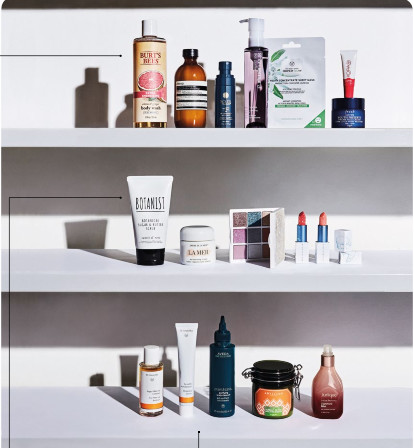Some beauty brands are eco-friendly right from the get-go, but many are getting onto the bandwagon.


Some beauty brands are eco-friendly right from the get-go, but many are getting onto the bandwagon. Here’s how they’re doing it.
ENCOURAGING RECYCLING OR OFFERING REFILLS
• Innisfree customers who bring empty bottles back to the store get membership points that can be converted into dollarvalue rebates. Members who forgo paper bags on the first Saturday of each month get free product samples. And during the brand’s annual EcoHandkerchief Campaign in June, purchases come with a specially designed handkerchief to encourage less use of tissue paper.
Jeju Pomegranate Revitalizing Skin, $30
• Beyond, a hair and body care line by The Face Shop Nature Collection, uses product packaging that you can put into the recycling bin without worrying about having to remove non-recyclable labels or pumps.
Professional Defense Conditioner, $39.90
• Bjork & Berries’ packaging is 100 per cent recyclable too.
White Forest Body Scrub, $51
• Tata Harper is Ecocertcertified. Its products are mostly in glass containers, which are easily recyclable. It also uses soya-based ink for printing to simplify the recycling process (conventional ink has to be removed from paper prior to recycling).
Resurfacing Mask, $85
• L’Occitane introduced eco-refills for 15 of its products in 2008. These use 90 per cent less material than the original containers, which were partially made with recycled plastic. The brand’s stores in France, Australia, Britain and Ireland all offer in-store recycling, and it aims to roll out this initiative worldwide by 2025.

USING SUSTAINABLE INGREDIENTS OR RECYCLED PACKAGING
• Burt’s Bees sources its beeswax, waxes and butters from community sources as much as possible to reduce its carbon footprint. Recyclable materials also make up 89 per cent of its packaging.
Citrus & Ginger Body Wash, $24
• Aesop’s ingredients are sustainably harvested and processed. And up to 60 per cent of its glass bottles and jars are made from recycled materials. Even the cartons used in the transportation of its products are 98 per cent recycled, unbleached fibreboard.
Gentle Facial Cleansing Milk, $70
• Soleil Toujours’ products are 100 per cent coral-reef safe. The company also commits to a net zero carbon footprint for its operations.
Organic Set + Protect Micro Mist SPF30, $55
• Shu Uemura uses sustainably sourced Japanese charcoal in its latest cleansing oil.
Blanc:chroma Lightening & Polishing Cleansing Oil, $55-$125
• The Body Shop’s new sheet mask is made with cellulose fibre from renewably sourced wood pulp. Plus, it is compostable and biodegradable.
Drops of Youth Youth Concentrate Sheet Mask, $9 a mask
• Kopari’s key ingredient in all its products is sustainably sourced coconut oil.
Coconut Lip Glossy, $22
• Fresh is big on using natural ingredients, but its Lotus Youth Preserve Dream Face Cream goes a step further – its key ingredient is a sustainably sourced flower called the Super Lotus. The lotus is pressed at the farming site, and any by-products are returned to the soil, to minimise the carbon footprint and environmental impact.
Lotus Youth Preserve Dream Face Cream, $89
GIVING BACK TO ENVIRONMENTAL CAUSES
• Botanist has been donating to the Save the Orangutan Forest Restoration Project (run by forest preservation organisation More Trees) in Indonesia, since July 2017.
Botanical Sugar & Butter Scrub Cassis & Rose, $23
• La Mer’s Blue Heart Oceans Fund supports ocean conservation projects. A portion of the brand’s proceeds goes into this fund, and every June, it designs limited-edition packaging for its Creme de la Mer to coincide with World Oceans Day. Also, its products use only sea kelp that has been sustainably harvested by hand.
Creme de La Mer, $150-$510
• Chantecaille will plant a tree in Kenya for every sale of the limited-edition sparkling Lip Cristal from its Spring 2019 collection. This collaboration with Sir David Attenborough of The Attenborough Foundation to counter the effects of global warming is one of many conservation efforts the brand takes part in.
Lip Cristal, $82
ADOPTING GREEN MANUFACTURING AND FARMING PROCESSES
• Dr Hauschka sources from organic, local or fair-trade farms wherever possible. It also initiates biological cultivation projects for ingredients not available organically. The brand has its own biodynamic herb garden and uses 100 per cent certified-green electricity in its operations.
Eye Make-up Remover and Cleansing Cream, $42 each
• Aveda uses 100 per cent wind energy at its primary manufacturing facility in the United States. It also works with suppliers that use renewable energy to produce its packaging.
Pramasana Purifying Scalp Cleanser, $61
• Abyssian uses abyssinian oil in its products. The abyssinian plant, sourced from farmers in South Africa, requires less fungicide, fertiliser and water to grow, making it more eco-friendly. The roots are left in the soil to fertilise the land for more sustainable farming. And the seeds are cold-pressed locally without solvents to minimise the impact on the environment.
Sunday Detox Exfoliating Shampoo, $56
• Jurlique engages in organic farming and has solar panels on its farm. The farm has sent zero waste to the landfill since 2016, uses recycled water to irrigate its crops, and makes its own compost too.
Herbal Recovery Signature Mist, $72























